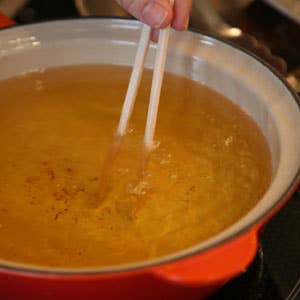
Hot Tip
Monitoring oil temperature is crucial when you're frying foods like our recipe for Crab Spring Rolls: too hot, and the rolls will burn; not hot enough, and they'll come out greasy. A deep-fry thermometer is one way to go, but there's another method that appeals to the minimalist in us. Cooks throughout Asia simply stick an unvarnished wooden or bamboo chopstick into the oil to test the heat. If the oil is hot enough, a steady stream of bubbles will issue from the submerged end of the chopstick. According to Brian Farkas, a professor of food science at North Carolina State University and an expert on heat transfer in immersion frying, the bubbles form because moisture trapped in trace amounts inside the wood or bamboo, when exposed to the hot oil, boils and escapes as steam. The hotter the oil, the more bubbles there will be. When we tested this method, we kept a thermometer handy to see how reliable a gauge of temperature the chopstick would be. As the mercury edged toward 320 degrees, a frail line of bubbles began to emanate from the chopstick's tip. When we gave the chopstick a dip at 350 degrees—the ideal temperature for frying the spring rolls—there was a swirl of bubbles all over. And by 375, the swirl had reached Jacuzzi-esque force. It takes a few fry-ups to master the reading of bubble intensity as clearly as one would the mercury in a thermometer, but once one has, there's something wonderfully Zen about dispensing with cooking by the numbers.
Keep Reading
Continue to Next Story










